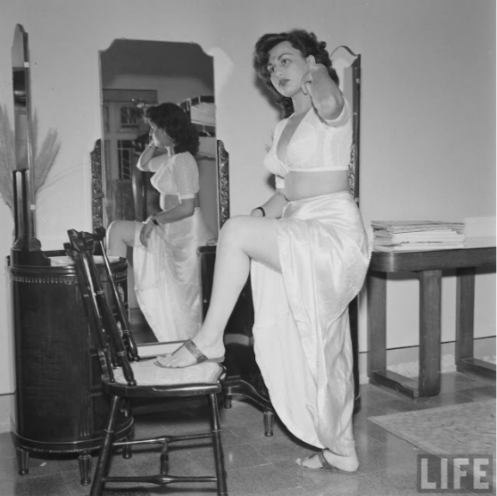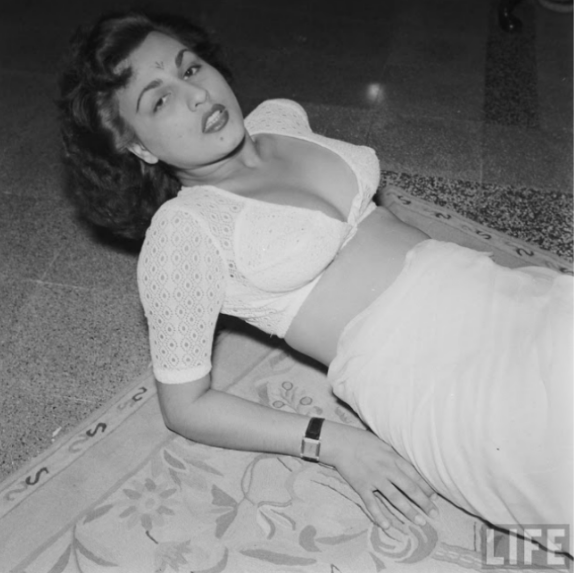At the nucleus of beauty
A symbol of undying beauty, the sari is not a temporal phenomenon.
Image Credit: Begum Para, 1951, photographed by James Burke for LIFE Magazine
In South Asian households, the term ‘evergreen’ boasts particular significance as the epitome of immortal beauty. Historically, unlike the West, there was a lack of distinguishable aesthetic movements in Southern Asia that would have lent themselves to permanence. From the 1920s to the 1950s, Hindi cinema was the arbiter of ideal femininity, as was Hollywood in propagating trends that have persisted for a century. A symbol of undying beauty, the sari is not a temporal phenomenon. It should instead be recognised as a longstanding icon of womanhood, having earned the epithet, ‘evergreen’.
Image Credit: Norma Talmadge, early 1920s, United States Library Congress of Prints
The stylistic cocktail of 1920s and 1930s Hollywood is pictorialised as such: drop-waisted dresses, geometric forms, and the overwhelming triumph of the gamine mystique, all before a gradual return to conservatism. Fashion was profoundly influenced by Hollywood as common dress failed to escape the magnetism of stars like Greta Garbo. The synergy between womanhood, fashion, and film became a salient point for the entertainment industry.
The realm of Hindi cinema, however, found inertia in an otherwise rapidly spinning world. Sound features were introduced to India at the beginning of the 1930s, usually providing escapist appeal for the masses plagued by growing frustrations with colonial rule. The advent of Hindi cinema coloured society as an invented stage upon which creative ideals made the lives of ordinary people increasingly dull — perhaps felt more strongly by South Asian women who lived under patriarchal norms.
The sari was already cemented as a cultural symbol of womanhood, but cinema personified it into an amalgamation of nationalism, tradition, and social status. Devika Rani, ‘the first lady of Indian cinema’, first appeared in Karma (1933) and in later films such as Acchut Kannya (1936). The portrayal of her characters centred around the “ideal Indian woman”, utilising the sari as an emblem of chastity and purity. Though, the la garçonne styles of the West seeped through the cultural veil of Bollywood in other ways. Indulging in a flapper redux several years later, Rani's on-screen style evolved to include finger waves, thin brows and a bold lip. The choice reflected the industry's desire to establish a traditional image imbued with the mystique of Western bravado.
Hindi cinema simultaneously introduced ‘Fearless Nadia’, an Australian-born actress. Most notable for her performance as a masked heroine in Hunterwali (1935), Nadia enjoyed the full extent of the flapper mien. She was unhindered by the norms of South Asian society: her characters were dressed androgynously in shorts, waistcoats, and formal trousers. The culmination of Nadia’s Western style, an antithesis to the sari, formed a foreign brand of allure that may have laid down the early roots of colourism in the industry.
Image Credit: Models in evening dresses made by Jeanne Lanvin, 1933, Brooklyn Museum Costume Collection at The Metropolitan Museum of Art, Gift of the Brooklyn Museum, 2009; Gift of Mark Walsh, 1984
During the 1940s, Hollywood utilised wartime guidelines — lowered hemlines and pinched waistlines — to embolden the femme fatale and remark upon a darker palette of femininity. As the 1950s emerged, so did the faces that would define the decade: Marilyn Monroe, Audrey Hepburn, and Brigitte Bardot, all of whom pioneered the new, sensual silhouette on screen.
The 1940s in South Asia were bracketed by the violence of World War II and the Partition between India and Pakistan. However, the 1940s marked the beginning of the Golden Age of Hindi cinema. In 1943, Kismet became the first blockbuster hit and would be known as the longest running hit of Indian cinema for the next thirty years. Other preeminent titles include Pyaasa (1957), Mother India (1957), and Kaagaz Ke Phool (1959).
The profound turmoil encouraged a return to familiarity on-screen, causing the exacerbation of female character archetypes in Hindi cinema. At odds with the female libertines proliferating in the West, the 'ideal Indian woman' was separated into 'ideal wife', ‘ideal daughter’,and 'ideal mother' who were paragons of sexual purity and fidelity. These characters pioneered the six-yard sari drape alongside trends that saw blouse necklines creeping higher.
Nargis Dutt often embodied these archetypes, particularly in Awaara (1941) and Mother India (1957). She articulated the luxe of Golden Age Hollywood through intricate on-screen appearances, often in makeup that paralleled Western trends. She earned the title ‘lady in white’ as she was frequently spotted in simplistic, all-white saris, which should typically be worn by widows. Although Nargis was not widowed, it was effective in rendering her as unreachable, beyond the displays of sexuality that were becoming more common as another archetype.
This archetype, known as ‘vamp’, was a potent departure from traditional South Asian femininity as characters sought to imitate Western women — oftentimes dressing in Western clothing and partaking in debauchery. Begum Para actively rebelled against patriarchal standards, developing a scandalous repertoire by appearing in films such as Neel Kamal (1947) and Jharna (1956). Para leaned unflinchingly into the vamp persona off-screen, her aesthetic markers carrying the strongest similarities to Hollywood stars at the time — short curly hair and sultry makeup. A 1951 photoshoot for Life magazine by James Burke featured a kaleidoscope of cigarettes, bare skin, a half-complete sari.
Though immortalised by means of film, the effects of time have relegated Bollywood actresses to the backdrop of cultural consciousness. However, there is some delight in knowing their images are used as reminders of timeless beauty, and at the centre of it all is the sari.






